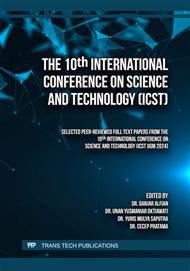[1]
S. Zahnia and D.W. Sumekar, "Kajian epidemiologis skizofrenia," Medical Journal of Lampung University 5, 160–166 (2016).
Google Scholar
[2]
M.R. Firmansyah, Pembuatan Aplikasi Game Menghitung Sederhana Sebagai Remediasi Kognitif Menggunakan Smartphone Bagi Penderita Skizofrenia, Bachelor's thesis, Universitas Muhammadiyah Yogyakarta (2022).
Google Scholar
[3]
S. D. Elvira and G. Hadisukanto, Buku Ajar Psikiatri Edisi ke-3 (Badan Penerbit Fakultas Kedokteran Universitas Indonesia, 2018).
Google Scholar
[4]
A. Fitrikasari and L. Kartikasari, Buku Ajar Skizofrenia (Universitas Diponegoro Press, 2022).
Google Scholar
[5]
R. Kail and L. K. Hall, "Distinguishing short-term memory from working memory," Memory & Cognition 29, 1–9 (2001).
DOI: 10.3758/bf03195735
Google Scholar
[6]
Isabelle Amado et. al., "a serious game to improve cognitive functions in schizophrenia: a pilot study," Frontiers in Psychiatry 7, 1–11 (2016).
Google Scholar
[7]
L.T. Miller and P.A. Vernon, "The general factor in short-term memory, intelligence, and reaction time," Intelligence 16, 5–29 (1992).
DOI: 10.1016/0160-2896(92)90023-k
Google Scholar
[8]
T.R.N. Maghribi, A. Nasikun, and D.D. Ariananda, Pengembangan Aplikasi Permainan untuk Meningkatkan Short Term Memory Penderita Skizofrenia Residual, Bachelor's thesis, Departemen Teknik Elektro dan Teknologi Informasi, Fakultas Teknik, Universitas Gadjah Mada (2023).
DOI: 10.24961/j.tek.ind.pert.2017.27.2.141
Google Scholar
[9]
F.S.F. Yani, Suryani, and I. Rafiyah, "Penerapan video game terhadap disfungsi kognitif pasien skizofrenia: A literature review," Prosiding Seminar Nasional dan Diseminasi Penelitian Kesehatan STIKes Bakti Tunas Husada Tasikmalaya 1 (2018).
DOI: 10.37090/jfl.v9i2.337
Google Scholar
[10]
Walter R. Boot et. al., "The effects of video game playing on attention, memory, and executive control," Acta Psychologica (2008).
DOI: 10.1016/j.actpsy.2008.09.005
Google Scholar
[11]
D. S. Yudhantara and R. Istiqomah, Sinopsis Skizofrenia untuk Mahasiswa Kedokteran (Universitas Brawijaya Press, 2018) p.2.
Google Scholar
[12]
Keputusan Menteri Kesehatan Nomor HK.02.02/MENKES/73/2015, Pedoman Nasional Pelayanan Kedokteran Jiwa Kementrian Kesehatan Republik Indonesia tahun 2015.
DOI: 10.29238/sanitasi.v8i2.6
Google Scholar
[13]
G. A. Radvansky, Human Memory - 3rd Edition (Routledge, Taylor and Francis Group, 2017).
Google Scholar
[14]
A. Hendriyanto and D. Juandi, "Mathematic achievement - intelligence quotient (iq) A study of simple relations in 10 high school students," Journal of Mathematics and Mathematics Education 12, 111–119 (2022).
DOI: 10.20961/jmme.v12i2.67981
Google Scholar
[15]
M.J.P. Wolf and B. Peron, "An introduction to the video game theory," Formats: revista de comunicació audiovisual (2005).
Google Scholar
[16]
C.C. Abt, Serious games (University press of America, 1987).
Google Scholar
[17]
T. Susi, M. Johannesson, and P. Backlund, "Serious games – an overview," Digitala Vetenskapliga Arkivet (2008).
Google Scholar
[18]
A. Calvo-Morata, C. Alonso-Fernández, M. Freire, I. Martínez-Ortiz, and B. Fernández-Manjón, "Serious games to prevent and detect bullying and cyberbullying: A systematic serious games and literature review," Computers & Education 157, 103958 (2020).
DOI: 10.1016/j.compedu.2020.103958
Google Scholar
[19]
A. Nasikun, B.Y. Wijonarko, R.B.A. Rahman, A.G. Persada, and S. Wibirama, "Virtual reality-based platformer games development for elevating architectural heritage awareness," IJITEE (International Journal of Information Technology and Electrical Engineering) 1, 93–97.
DOI: 10.22146/ijitee.33592
Google Scholar
[20]
S. Hart, A. Margheri, F. Paci, and V. Sassone, "Riskio: A serious game for cyber security awareness and education," Computers & Security 95, 101827 (2020).
DOI: 10.1016/j.cose.2020.101827
Google Scholar
[21]
T. Martins, V. Carvalho, and F. Soares, "Physioland–a serious game for physical rehabilitation of patients with neurological diseases," Enter- tainment Computing 34, 100356 (2020).
DOI: 10.1016/j.entcom.2020.100356
Google Scholar
[22]
R. Ramadan and Y. Widyani, "Game development life cycle guidelines," International Conference on Advanced Computer Science and Infor- mation Systems (ICACSIS) (2013).
DOI: 10.1109/icacsis.2013.6761558
Google Scholar
[23]
R. Ramadan and Y. Widyani, "Game development life cycle guidelines," in 2013 International Conference on Advanced Computer Science and Information Systems (ICACSIS) (IEEE, 2013) p.95–100.
DOI: 10.1109/icacsis.2013.6761558
Google Scholar
[24]
S.H. Edwards, "A framework for practical, automated black-box testing of component-based software," Software Testing, Verification and Reliability 11, 97–111 (2001).
DOI: 10.1002/stvr.224
Google Scholar
[25]
M.E. Khan and F. Khan, "A comparative study of white box, black box and grey box testing techniques," International Journal of Advanced Computer Science and Applications 3 (2012).
DOI: 10.14569/ijacsa.2012.030603
Google Scholar
[26]
C. Inc, "Cognifit memory test," (2023), https://www.cognifit.com/memory-test [Accessed: (25 July 2023)].J. Cuzick, "A wilcoxon-type test for trend," Statistics in medicine 4, 87–90 (1985).
DOI: 10.1002/sim.4780040112
Google Scholar
[27]
R. Chen, C. Li, C. Li, H. Fang, R. Lu, W. Yao, W. Li, and X. He, "Phase-shift angle segmentation modulation for soft-switching medium voltage dab converter with series-connected sic mosfets," IEEE Transactions on Transportation Electrification, 1–1 (2023).
DOI: 10.1109/tte.2023.3265112
Google Scholar


